John C. Calhoun Worksheets
Do you want to save dozens of hours in time? Get your evenings and weekends back? Be able to teach about John C. Calhoun to your students?
Our worksheet bundle includes a fact file and printable worksheets and student activities. Perfect for both the classroom and homeschooling!
Resource Examples
Click any of the example images below to view a larger version.
Fact File
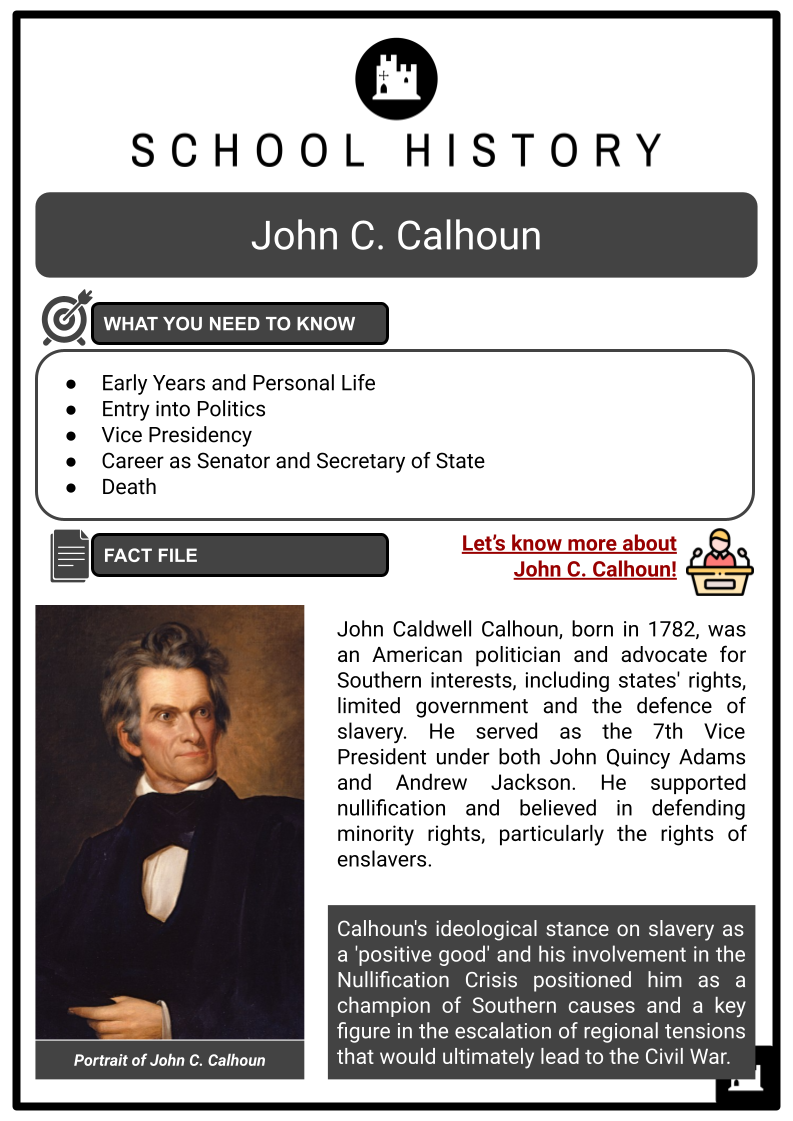
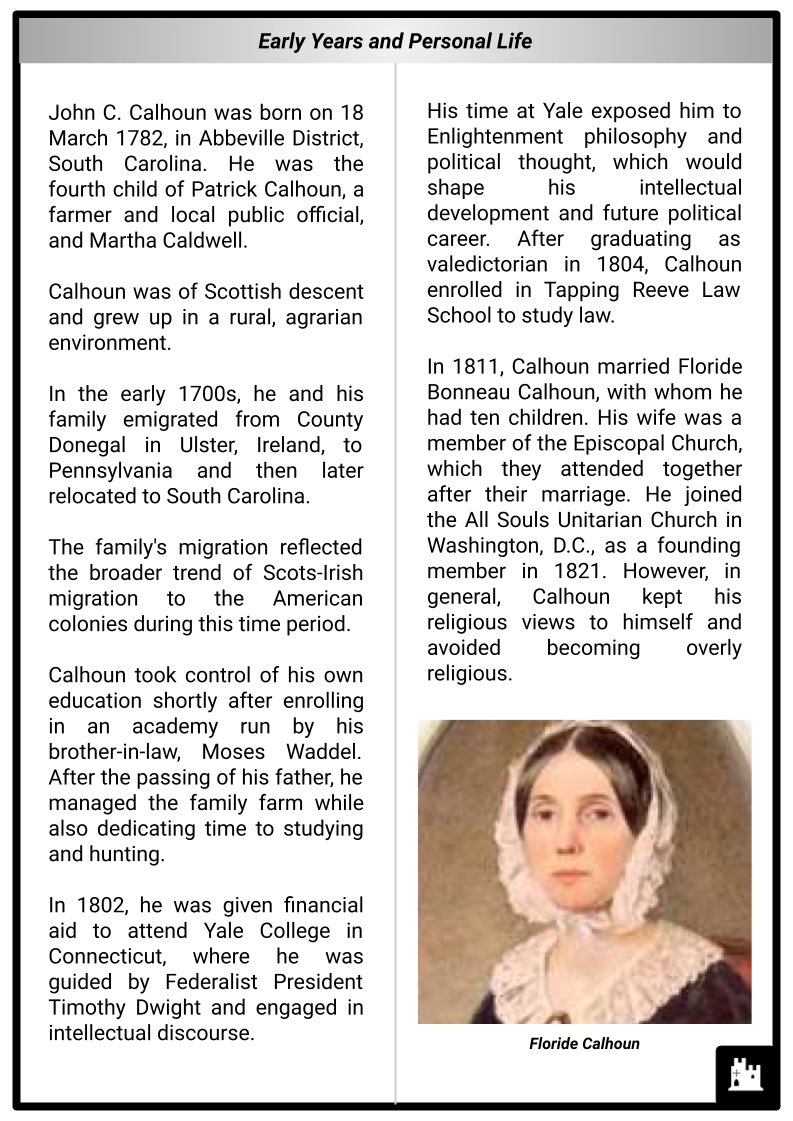
Student Activities
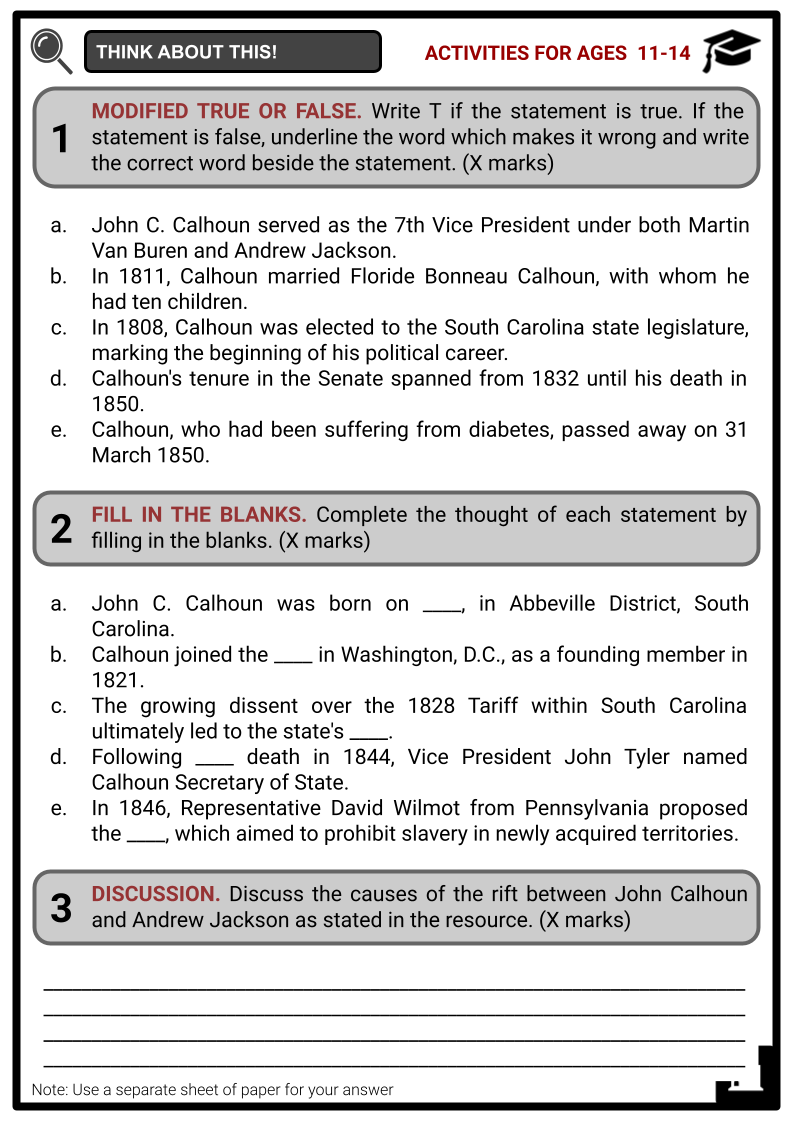
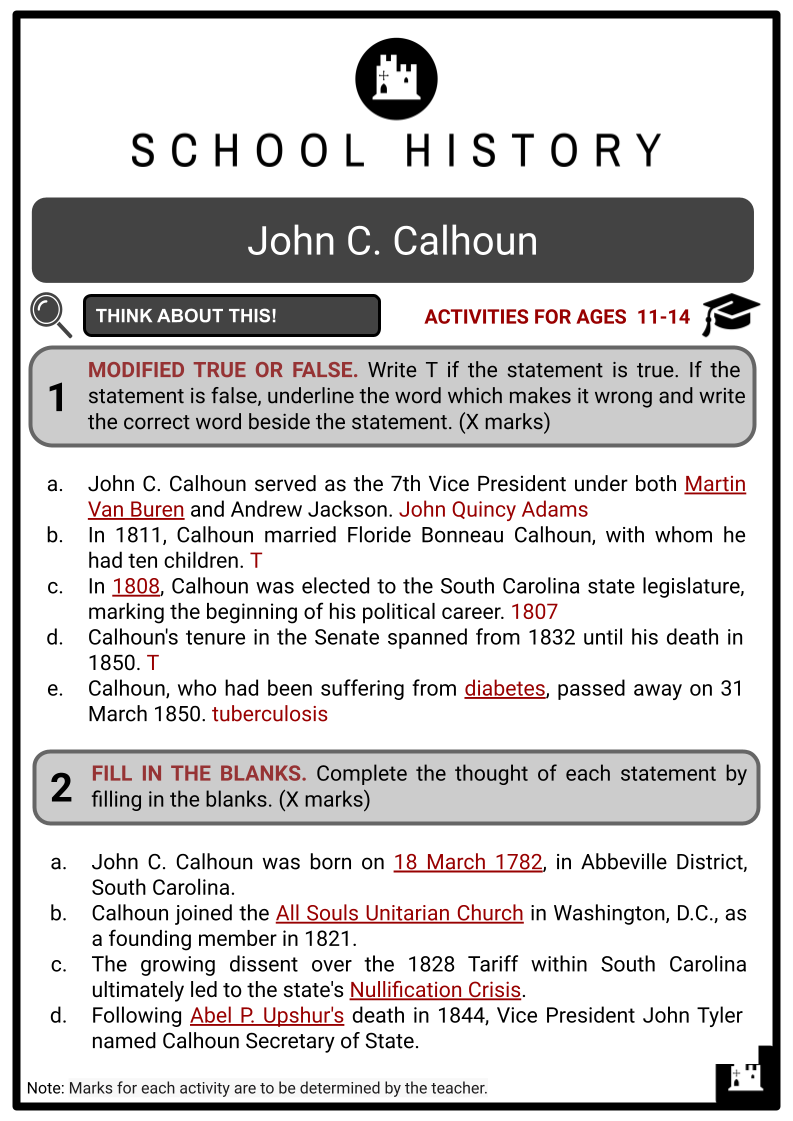
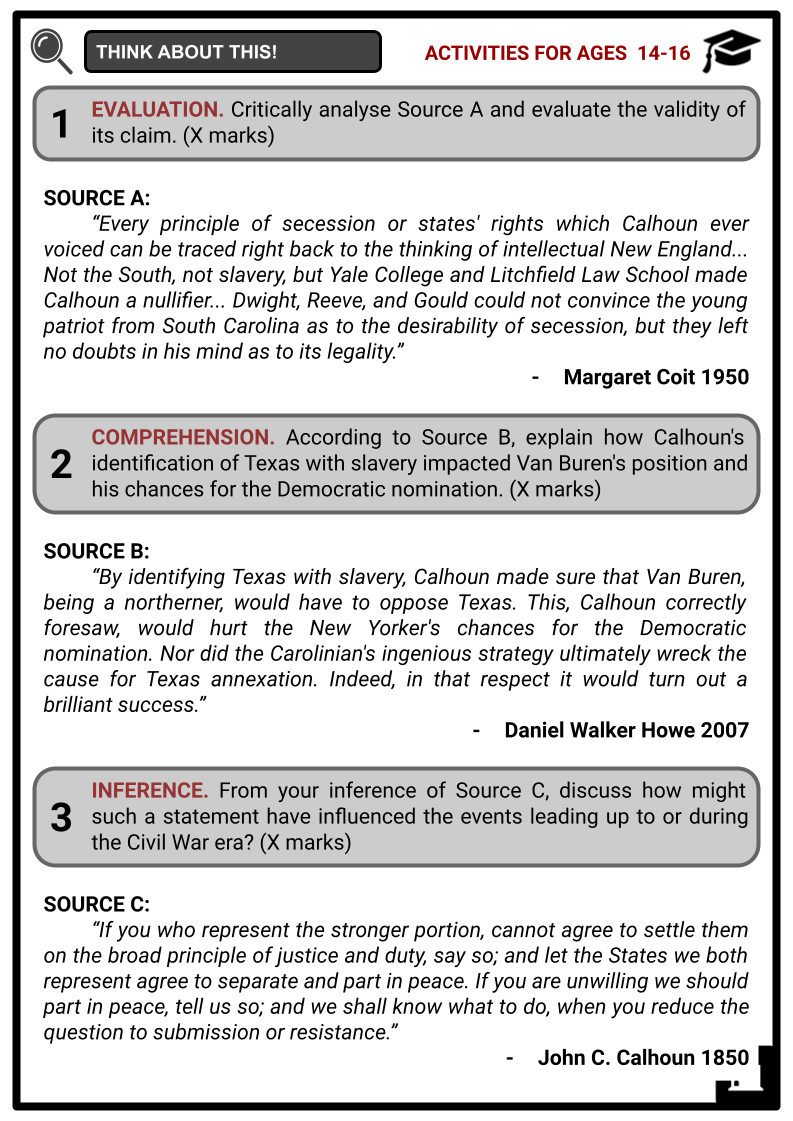
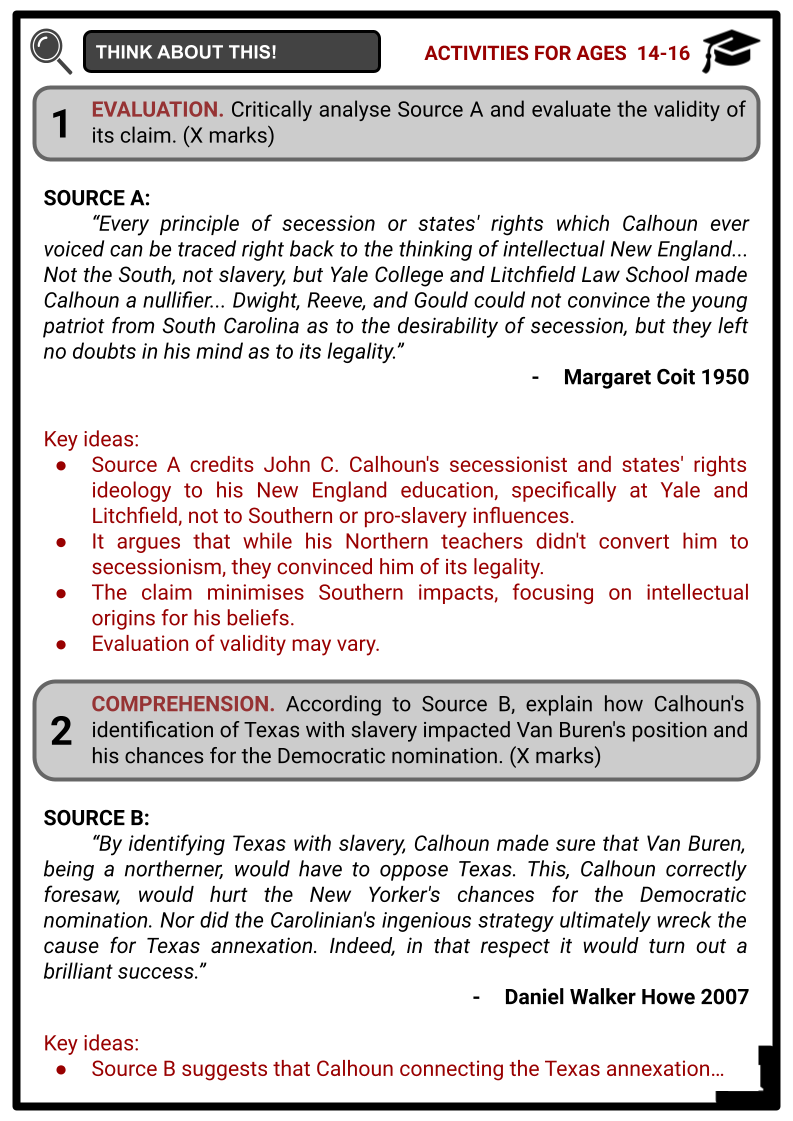
Summary
- Early Years and Personal Life
- Entry into Politics
- Vice Presidency
- Career as Senator and Secretary of State
- Death
Key Facts And Information
Let’s know more about John C. Calhoun!
John Caldwell Calhoun, born in 1782, was an American politician and advocate for Southern interests, including states' rights, limited government and the defence of slavery. He served as the 7th Vice President under both John Quincy Adams and Andrew Jackson. He supported nullification and believed in defending minority rights, particularly the rights of enslavers.
Calhoun's ideological stance on slavery as a 'positive good' and his involvement in the Nullification Crisis positioned him as a champion of Southern causes and a key figure in the escalation of regional tensions that would ultimately lead to the Civil War.
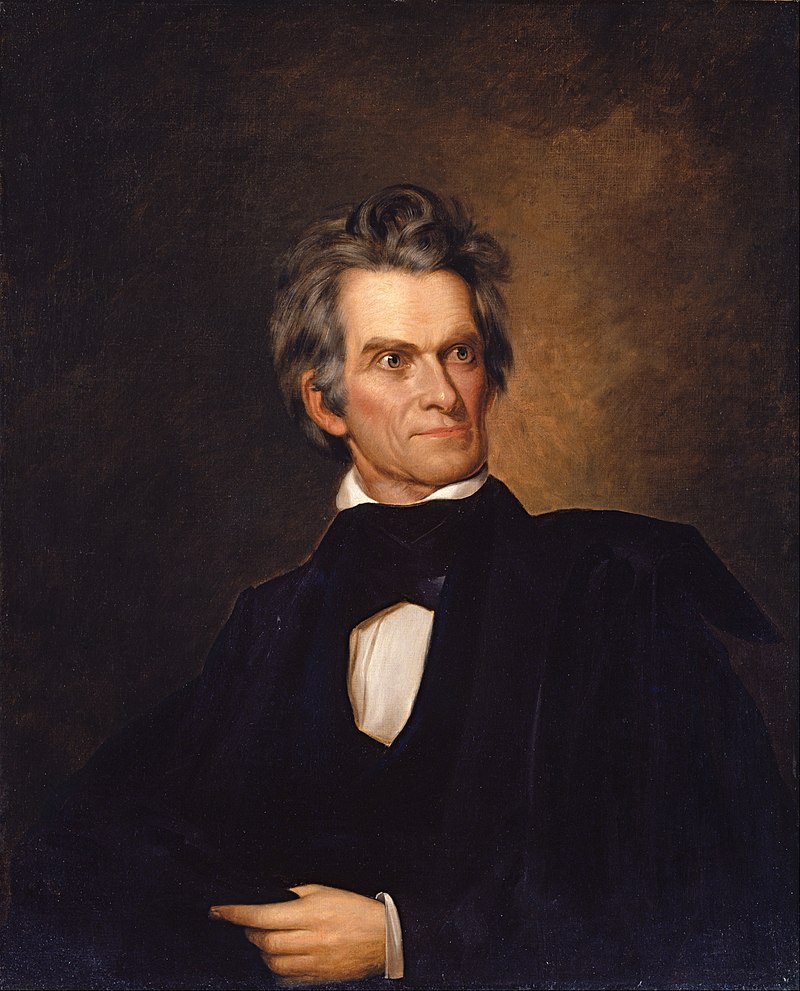
Early Years and Personal Life
- John C. Calhoun was born on 18 March 1782, in Abbeville District, South Carolina. He was the fourth child of Patrick Calhoun, a farmer and local public official, and Martha Caldwell.
- Calhoun was of Scottish descent and grew up in a rural, agrarian environment.
- In the early 1700s, he and his family emigrated from County Donegal in Ulster, Ireland, to Pennsylvania and then later relocated to South Carolina.
- The family's migration reflected the broader trend of Scots-Irish migration to the American colonies during this time period.
- Calhoun took control of his own education shortly after enrolling in an academy run by his brother-in-law, Moses Waddel. After the passing of his father, he managed the family farm while also dedicating time to studying and hunting.
- In 1802, he was given financial aid to attend Yale College in Connecticut, where he was guided by Federalist President Timothy Dwight and engaged in intellectual discourse.
- His time at Yale exposed him to Enlightenment philosophy and political thought, which would shape his intellectual development and future political career. After graduating as valedictorian in 1804, Calhoun enrolled in Tapping Reeve Law School to study law.
- In 1811, Calhoun married Floride Bonneau Calhoun, with whom he had ten children. His wife was a member of the Episcopal Church, which they attended together after their marriage. He joined the All Souls Unitarian Church in Washington, D.C., as a founding member in 1821. However, in general, Calhoun kept his religious views to himself and avoided becoming overly religious.
Entry into Politics
- In 1807, Calhoun was elected to the South Carolina state legislature, marking the beginning of his political career. As he gained more recognition for his political skills and persuasive oratory, he was elected to the US House of Representatives in 1810.
- He became known as an ardent nationalist during his time as a lawmaker by endorsing the War of 1812 and backing President James Madison's government.
- One of Calhoun's postwar goals was to consolidate and fortify the War Department. He advocated for the establishment of an effective nation, the construction of 'great permanent roads', and the promotion of local manufacturing.
- He demanded an internal tax structure that would not crumble in the face of a reduction in maritime trade during a war. In addition, he advocated for the establishment of the Second Bank of the United States as a new national bank to revitalise and modernise the economy.
- Calhoun's passion for policies promoting the interests of his nation remained a defining aspect of his career, leading to his appointment as Secretary of War under President James Monroe in 1817. During his tenure, Calhoun prioritised military preparedness and infrastructure development.
- He oversaw the affairs of Indigenous peoples and supported the idea of moving them to reserves in the West in order to maintain their sovereignty. He established the Bureau of Indian Affairs in 1824.
- During the First Seminole War, he opposed General Jackson's invasion of Spanish Florida and backed the execution of British soldiers who were suspected of instigating the Seminoles to wage war against the United States.
Vice Presidency
- After securing a definitive electoral win as Vice President in December 1824, Calhoun initially served under President John Quincy Adams. He faced the challenge of navigating the divisive issue of high tariffs during Adams' administration.
- Adams, along with many Northern industrialists, supported high tariffs to protect American industries from foreign competition. This protectionist approach was seen as crucial for the development of domestic manufacturing, especially in the Northern States.
- While Calhoun had previously been an advocate of protective tariffs, his home state of South Carolina, which relied more on agriculture, opposed these high tariffs. This conflict of interest put Calhoun in a challenging position as he tried to navigate the demands of his home state and the administration he served.
The Petticoat Affair contributed to the eventual reshuffling of Jackson's Cabinet, with several members resigning. This reshuffling is sometimes called the 'Cabinet reorganization of 1831'.
- Calhoun's dissatisfaction with Adams' administration reinforced his decision to align with Andrew Jackson, whose views on states' rights and federal overreach more closely resembled his own.
- This alignment led to Calhoun becoming Vice President under Jackson after the 1828 election, marking him the second Vice President in US history to serve under two different Presidents, with George Clinton being the first.
- During the Jackson administration, Calhoun found himself at the centre of the Petticoat Affair.
- Jackson's Cabinet was shaken by the scandal involving Peggy Eaton, the wife of Secretary of War John Eaton, who was socially shunned by the wives of other Cabinet members, primarily Calhoun's wife, Floride Bonneau.
- The relationship between Calhoun and Jackson turned sour when the latter fired most of his Cabinet members and sided with Van Buren, who supported the Eatons, in the Petticoat Affair.
- The Calhoun–Jackson rift was also worsened by their differing views on the 1828 tariff, eventually referred to derogatively as the 'Tariff of Abominations' by its Southern critics.
- This referred to the tariff law that was designed to protect industry in the northern United States. However, it imposed high tariffs on imported goods, particularly raw materials, which were primarily purchased by the Southern states.
- This resulted in a notable rise in the price of manufactured items, sparking dissatisfaction among the Southern states and triggering widespread opposition to the tariff.
- The tariff created a deep divide between the Northern and Southern states, with the South viewing it as a form of economic oppression.
- The growing dissent over the tariff within South Carolina ultimately led to the state's Nullification Crisis, where the state declared the tariff null and void within its borders. Calhoun, holding to the principles of states' rights, supported South Carolina's position and vehemently opposed the tariff.
- In response to this legislation, Calhoun retreated to his South Carolina plantation to pen the South Carolina Exposition and Protest, articulating his argument against centralised power and advocating for the doctrine of nullification.
- The Jackson-backed Tariff of 1832 sought to mitigate the conflict by lowering rates, yet the South Carolina Nullification Convention of that same year escalated the situation.
- The convention nullified both the 1828 and 1832 tariffs and threatened secession should the federal government attempt to enforce these tariffs, a clear expression of state defiance against federal authority.
- In a dramatic turn, Calhoun would resign from the vice presidency in 1832 to fill a vacant Senate seat, taking the place of Senator Robert Y. Hayne, who had resigned to become governor.
The issues and tensions raised during the Tariff of 1828 controversy foreshadowed the economic and political conflicts that would eventually lead to the American Civil War.
Career as Senator and Secretary of State
- Calhoun's tenure in the Senate spanned from 1832 until his death in 1850. Because of his role in the Nullification Crisis, he had little hope of winning the presidency. Even though the Nullifier Party founded the Whig Party after the Compromise Tariff of 1833, he occasionally chose to remain independent.
- In the midst of the Bank War from 1833 to 1834, Calhoun opposed Jackson's withdrawal of federal funds from the Second Bank, accusing him of corruption and financial ignorance. In favour of censuring Jackson's withdrawal of funds, he sided with the Whig senators by casting his vote. He backed the independent Treasury system and worked with Van Buren to regain his national prominence.
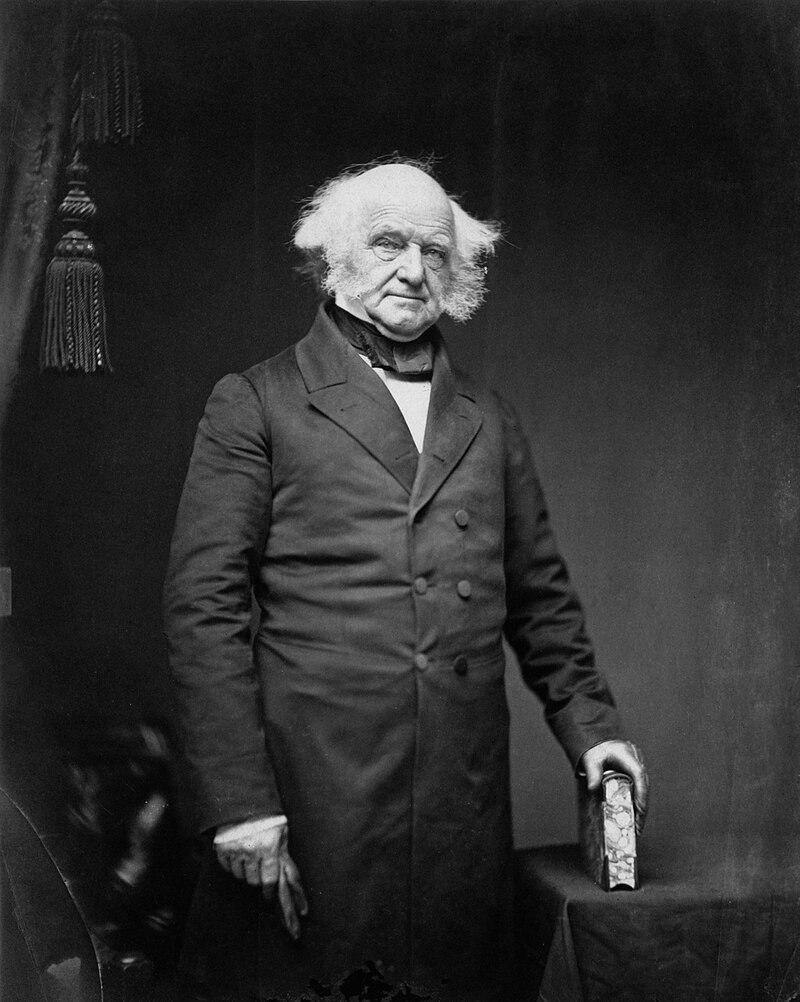
- In Calhoun's attempt to run for President in 1844, he resigned from the Senate in 1843. However, his campaign was ultimately unsuccessful, as he failed to secure the nomination from the Democratic Party.
- Following Abel P. Upshur's death in 1844, Vice President John Tyler named Calhoun Secretary of State. Tyler's government suffered a great deal with Calhoun's appointment because Tyler wanted to negotiate an annexation contract with Texas.
- From 1843, Tyler and his allies had been pushing for Texas's annexation while downplaying the goals of Southern enslavers. Tyler presented the annexation as advantageous from an economic standpoint, undermining white reliance on slave labour and attachment.
- Additionally, Tyler warned that the country's security was in jeopardy because Texas would give up slavery as a result of growing influence from foreign nations, especially Britain, and because the rivalry between American free-soil and slave-soil interests would intensify on a sectional basis.
- The hiring of Calhoun threatened to undermine Tyler's nationalist reputation, but in the wake of the Princeton debacle, Tyler felt compelled to take Calhoun on board because one of his personal friends had offered the job.
The 'Princeton debacle' was a naval disaster that occurred on 28 February 1844 and involved the explosion of a large naval gun aboard the USS Princeton.
- Tyler brought his new Secretary of State into the treaty negotiations after failing to conclude the negotiations with Calhoun in Washington, D.C., due to delays in the arrival of important Texas officials. Calhoun was instructed to abide by the protection promises made by former Secretary Upshur and arrange for US military action in the event that Mexico used force to occupy Texas.
- Calhoun signed the annexation deal on 22 April 1844, and then brought it before the Senate for discussion in private.
- Senator Benjamin Tappan of Ohio, who opposed annexation and slavery, leaked information about the intricacies of the treaty discussions and the supporting documentation to the media.
- The Tyler-Texas Treaty's provisions revealed the annexation drive to be a scheme to spread and maintain slavery.
- By a vote of more than 2 to 1, the Senate rejected the treaty, 16 to 35. The revelation of the treaty turned the annexation of Texas into a major political issue for the 1844 general election.
- In 1845, Calhoun was re-elected to the Senate and staunchly opposed the Mexican-American War. He believed the conflict would weaken republicanism and strengthen imperialism.
- In 1846, Representative David Wilmot from Pennsylvania proposed the Wilmot Proviso, which aimed to prohibit slavery in newly acquired territories. Calhoun also opposed this proposal.
- A compromise was reached in the Oregon boundary dispute between the United States and Great Britain, wherein the Americans accepted Washington and Oregon and the British acquired British Columbia. On 18 June 1846, the treaty was approved by a vote of 41 to 14. To address the problem of slavery on recently acquired lands, the Compromise of 1850 was devised. Calhoun called the Nashville Convention to discuss potential Southern independence, but pro-slavery Southerners were against it.
- In his speech, Calhoun criticised the Compromise and claimed that the South should be allowed to separate from the Union due to the North's disregard for Southern interests and the issue of slavery.
- He cautioned that if the balance between the two sectors was disturbed, disunion, anarchy and civil war might ensue. Though the Compromise measures were eventually passed, Calhoun died shortly after, and his views on states' rights gained traction throughout the South.
Death
- Calhoun, who had been suffering from tuberculosis, passed away on 31 March 1850 at the Old Brick Capitol boarding home in Washington, D.C. He is lastly quoted saying, 'The South, the poor South!'
- He was laid to rest in Charleston, South Carolina's St. Philip's Churchyard.
- A group of his friends transported his casket to a hiding place behind the church stairs during the night during the Civil War, fearing that Federal troops might desecrate his burial.
- His coffin was buried the same evening in an unmarked cemetery close to the church, where it stayed until 1871, when it was dug up once more and moved back to its original location.
- The site of Calhoun's Fort Hill farm, which he left to his wife and daughter, is now home to the Clemson University campus in South Carolina. Floride Calhoun passed away in 1866 and was interred separately from her husband but close to their children in Pendleton, South Carolina's St. Paul's Episcopal Church Cemetery.
Image Sources
- https://upload.wikimedia.org/wikipedia/commons/thumb/6/6e/George_Peter_Alexander_Healy_-_John_C._Calhoun_-_Google_Art_Project.jpg/800px-George_Peter_Alexander_Healy_-_John_C._Calhoun_-_Google_Art_Project.jpg
- https://upload.wikimedia.org/wikipedia/commons/thumb/1/1f/Martin_Van_Buren_by_Mathew_Brady_c1855-58.jpg/800px-Martin_Van_Buren_by_Mathew_Brady_c1855-58.jpg
Frequently Asked Questions
- Who was John C. Calhoun?
John C. Calhoun was a prominent American statesman and political theorist who served as the 7th Vice President of the United States under John Quincy Adams and Andrew Jackson.
- What were John C. Calhoun's political beliefs?
Calhoun was a staunch advocate of states' rights and nullification, believing that states had the right to nullify federal laws they deemed unconstitutional. He was also a defender of slavery and argued for its expansion into new territories.
- What role did John C. Calhoun play in American history?
Calhoun played a significant role in shaping American politics in the first half of the 19th century. He served as Vice President, Secretary of State, Secretary of War, and senator. His ideas on states' rights and nullification were central to the debates over states' rights versus federal authority.
